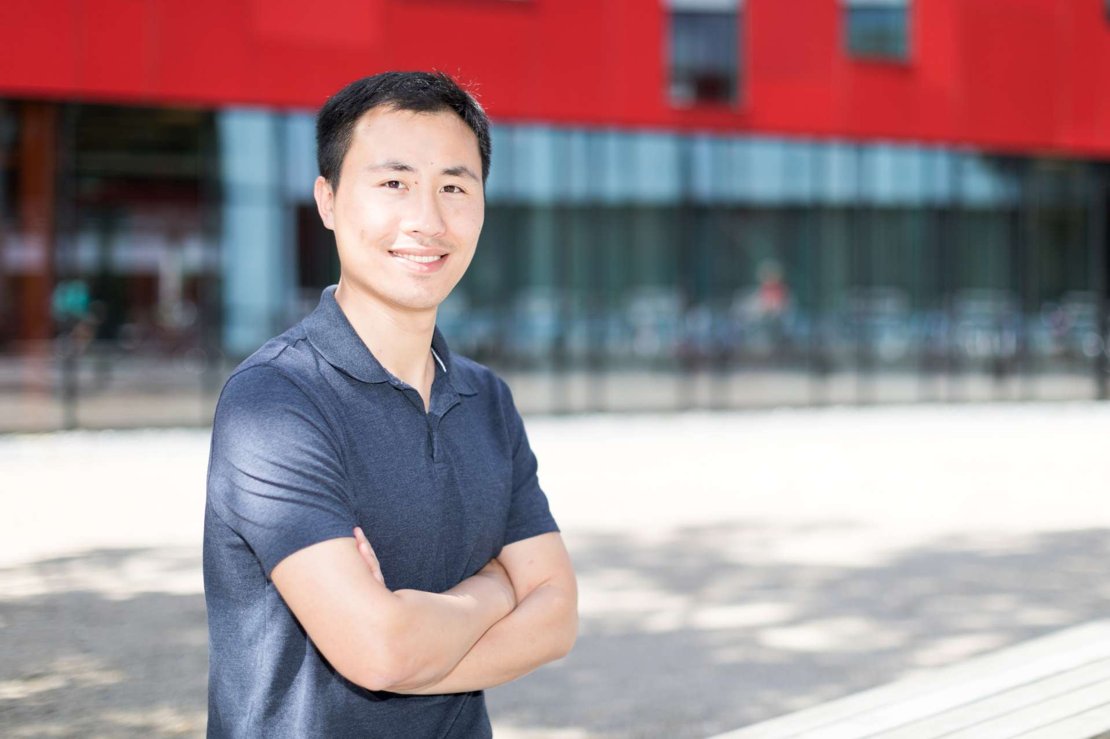Optical integration on chip is awaiting a bright future. Jinfeng Mu, who succesfully defended his PhD thesis on June 7th, hopes to be part of this exciting, yet unforeseeable, road ahead. In his PhD work, performed at the Optical Sciences Group, he focused on diverse functionalities, brought together on one single optical chip. ‘Collaborating with cleanroom experts and spin-off company experts, served as a powerful tool for my research,’ Jinfeng says. ‘By gradually learning up-to-date fabrication technologies, I was able to test unprecedented optical functionalities. I combined these on a double layer chip platform.’
DISTINCTIVE BENEFITS
In his extensive PhD work, Jinfeng had five articles published in leading scientific journals. He proposed an innovative double-layer photonic platform for active-passive integrations. 'Herein, outstanding optical features of silican nitride (Si3N4), are combined with the interface properties of rare-earth-ion doped aluminium oxide (Al2O3),' Jinfeng explains. ‘By doing so, the distinctive benefits of optical chips come within reach: low energy loss on the chip, ultra-broadband operation, and tolerant overlay for mass production.’
OPTICAL AMPLIFIER
As a token of his skills, Jinfeng proudly mentions the first integrated optical amplifier. He was the first to design and fabricate it, from scratch, on the developed double-layer platform technologies. He experimentally showed its high net gain. ‘For our type of scientific research, fabrication of complex chips is a decisive tool,’ Jinfeng says. ‘I was eager to learn the various fabrication steps involved, one by one. Mesa+ and the advanced spin-off companies involved were of decisive help. Without them I would have been lost.’
FACILITIES AND EXPERTISE
Jinfeng praises the well-equiped Mesa+ Nanolab facilities. During his PhD work, he felt free to use all of them, and calling in expert advice whenever needed. ‘Diverse optical research groups are active at Mesa+, covering a various range of topics,’ Jinfeng says. ‘I enjoyed discussing my work and that of PhD colleagues during monthly meetings, at the umbrella Appied Nanophotonics (ANP) network. We presented our work, shared experiences and discussed problems, leading to new collaboration and creative solution routes. It was very inspiring.’

PARTNERS
Standing side by side in the Mesa+ Nanolab with experts from user committee of the project, like UT spin company Lionix International, was also of great importance, Jinfeng stresses. ‘Spin-off companies make commercial use of the Nanolab facilities,’ he says. ‘They were willing to share their experiences, on general fabrication skills and operating the equipment. They also provided me with samples that I needed. By using similar fabrication techniques, and refining them for my needs, I was able to build complex innovative optical chips, really challenging the functional boundaries.’
Jinfeng also mentions his collaboration with other partners, notably Phoenix Software (now Synopsys OptoDesigner). ‘By using their simulation and error-tracing software, I could strategically design components and multilayer layouts to carry out fabrication of the chips. All specs were well characterized in the in-house lab. I could be sure the chips were future-proof and suitable for mass production one day.’
FUTURE
Now that he has obtained his PhD, Jinfeng plans to go and work in industry. ‘I prefer performing R&D in a bigger company, or in a small company possessing ambitious growth plans,’ he says. ‘Collaborating with spin-off companies pushed me quite a lot. Perhaps one day I will become an entrepreneur myself. But at first, building up extra experience is important. As a start-up company, apart from performing research and developing valuable products, many other things ask for simultaneous attention. Such as: finding trustworthy expertise partners; finding launching customers, investors and subsidiary agents; and formulating a good business model. I have to build up extra skills in the years to come.’
OPTICS IN TWENTE
According to Jinfeng Twente is an attractive region for optical entrepreneurship. ‘The optics expertise areas at the University of Twente are extremely promising,’ he says. ‘However, the spin-off companies in the region of Twente do not reflect this variety as yet. To become of international importance, apart from supporting spin-offs in their first stages, some type of internal competition could have a stimulating effect. I like to work within a competitive environment, really pushing products into the market.’
Writer: Egbert van Hattem
